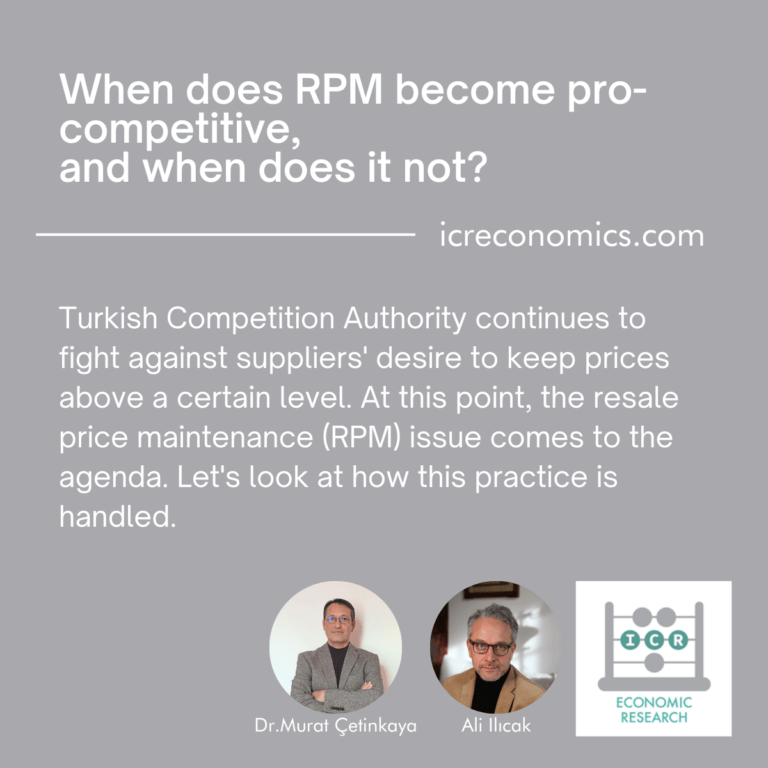
Competition authorities, particularly the Turkish Competition Authority (TCA), continue to fight against suppliers’ desire to keep prices above a certain level. At this point, the resale price maintenance (RPM) issue comes to the agenda, which a manufacturer or importer can implement without the need to communicate with its competitor, and the higher the market share, the more success it can achieve. Let’s look at how this practice is handled.
According to the Group Exemption Communiqué on Vertical Agreements, the prevention of the buyer’s freedom to determine its own sales price is among the vertical restrictions that exclude a vertical agreement from the scope of group exemption. In this context, it is only possible for the supplier to determine the maximum sales price or recommend the sales price, provided that it does not turn into a fixed or minimum sales price due to the pressure or incentive of any of the parties. The fact that these prices are maximum or recommended must be indicated in the published price lists or on the product itself.
In the EU Vertical Guidelines, RPM is also listed among the hardcore restrictions. Unlike the Guidelines in Turkey, the EU Guidelines includes seven factors that may distort intra-brand or inter-brand competition and four examples where RPM may be effective.
According to the EU Guidelines, how RPM (intra-brand or inter-brand) may distort competition is briefly stated as follows:
- Distorting competition at the provider level: Facilitating collusion between providers by leading to price transparency in the market. It is also noted that this is more likely to occur if providers operate in an oligopolistic market or if RPM is applied in a significant part of the market.
- Distorting competition at the distributor level: This is more likely to occur where providers particularly favour the application of RPM.
- Distorting competition between providers and distributors: The stretching of competition here would arise, mainly where providers use the same distributors to distribute their products and RPM is applied by all or most of them.
- Reducing pressure on the profit margin of the provider
- Preventing or making difficult the entry and expansion of new or more efficient forms of distribution, thus reducing innovation at the distribution level;
- Prevent the entry of small competitors of the provider
- Reducing intra-brand competition, leading to higher retail prices.
Again, as stated in the EU Guidelines, RPM may also lead to various efficiencies, particularly where the provider directs it. In such cases, i.e. when undertakings rely on an efficiency defence for RPM, this defence must be able to prove with concrete evidence that the conditions for individual exemption are met. The four examples of such activities given in the Guidelines are as follows:
- Where a supplier introduces a new product, the RPM may be an effective tool to encourage distributors to take better account of the manufacturer’s interest in promoting that product. In such a case, it is possible to tolerate the application of RPM for a certain period, in the absence of a less restrictive instrument.
- Fixed resale prices, and not just maximum resale prices, may be necessary to organise a coordinated shortterm low price campaign (of 2 to 6 weeks in most cases), particularly in a distribution system where the supplier applies a uniform distribution format, such as a franchise system.
- A minimum resale price or minimum advertised price can be used to prevent a particular distributor from using the product of a supplier as a loss leader
- In some situations, the extra margin provided by RPM may allow retailers to provide additional pre-sales services, in particular in the case of complex products. Thus, with the RPM application, free-riding distributors are prevented from selling products at lower prices and pre-sales activities are prevented from being harmed.
In this framework, although it is considered a hardcore restriction, there is no obstacle for an RPM to obtain an individual exemption if certain conditions are met. It should be noted here that the relevant undertaking should prove that the conditions for exemption are met, i.e. the necessity of the RPM practice and the activities it will create. Although the TCA’s Vertical Guidelines does not provide guidance on RPM in this detail, we believe there is no need to emphasise that the EU practice will also be accepted as applicable in Turkey as a deemed legislation.
On the other hand, although the burden of proof in an individual exemption application is on the undertaking, in our opinion, it will also be necessary for the TCA to prove and demonstrate to a certain extent that anti-competitive effects or consequences have arisen due to such a practice when it initiates a competition investigation under Article 4 or 6 due to an RPM practice.
Despite the strict approach in Turkish practice today, the possible adverse effects of RPM are more uncertain than the effects of a price cartel in which horizontal price fixing between competitors takes place. On the other hand, even in the 7 cases set out in the EU Guidelines, which justify the exclusion of RPM from the scope of the group exemption, the occurrence of a loss of consumer welfare is always subject to certain conditions. In addition, while the negative impact on consumer welfare is less, it may negatively affect producer welfare. In such a case, if a policy prioritising consumer welfare is followed, it will be difficult to impose a sanction against the undertaking due to RPM.
One of the main arguments against RPM, which we can say that there is a consensus, is that it may be used as a facilitator of anti-competitive cooperation in upstream or downstream markets. The application of RPM that may lead to horizontal distortion of competition at the distributor level may arise due to distributors who agree with each other or distributor(s) having a strong bargaining power against the supplier pressuring the supplier to apply RPM. In such cases, competition authorities have no solution other than to conduct a typical cartel investigation. In such cartels, where RPM is often used as a tool, it is difficult to disprove the concrete evidence obtained. In such cases, RPM can also be used to identify members who deviate from cartel-type cooperation. From the consumers’ point of view, it has been widely emphasised that the prominent possible negative effect of minimum RPM may be increased prices. At the same time, the studies also suggest that the provider’s profit margin may increase due to the reduction of intra-brand competition through minimum RPM. In such a case, the incentives of the provider(s) to make efficiency-generating investments in the upstream market will eventually be dampened.
However, in addition to all these possible anti-competitive effects, studies show that minimum RPM implementation may create competitive effects by increasing intra-brand and inter-brand competition. It is generally accepted that the problem of free-riding is the most important argument in favour of minimum RPM. In this context, minimum RPM may provide positive efficiency contributions to overcome free-rider practices at the distributor level that may damage the perception of the quality of the product in terms of after-sales services, necessary training and information, etc.[1]
On the other hand, beyond the free-rider problem, it is also put forth that, in times of demand uncertainty, minimum RPM can also be used to eliminate the negative effects of these uncertainties. For example, it is possible to face such uncertainty when distributors have to periodically order product stocks from a manufacturer before the demand for the product arises. The fact that distributors are free to raise or lower prices after demand has been established, to deplete their own stocks, can lead to considerable price fluctuations. In such a situation, a supplier’s use of RPM to prevent retail prices from falling below a minimum level during unexpected demand slack may contribute positively to consumer welfare.[2]
As can be seen, economists have different views on whether RPM is always a harmful practice for consumers. As Kollmar analyses in detail[3], economists in the literature have developed about nine anti-competitive theories and 19 different pro-competitive theories to explain the motivation behind a provider’s use of RPM to achieve its distribution objectives. In this context, Kollmar (20323) states that even from the number of models alone, it is clear that most of the various explanations of RPM are pro-competitive, resulting in a general view that RPM is advantageous in generating efficiency in retail services and increasing interbrand competition.
Due to these considerations, it becomes important to determine the extent to which the existing theories of harm and possible efficiencies are valid in each case rather than looking at RPM strictly as an anti-competitive practice under all circumstances. In this context, it would be appropriate for competition authorities to conduct a detailed analysis with all the tools at their disposal, taking into account the specific circumstances of each case, instead of placing the burden of proof solely on undertakings, at least in individual exemption assessments and investigations, taking into account the possible increases in consumer welfare.
[1] For a more detailed overview of pros and cons of RPM see: OECD (2008), Resale Price Maintenance, Policy Roundtable; Swedish Competition Authority (2008), The Pros and Cons of Vertical Restraints; Marvel, H.P., The Resale Price Maintenance Controversy: Beyond the Conventional Wisdom, Antitrust Law Journal, V: 63, No: 1; Bennett, M., Fletcher, A., Giovannetti, E., Stallibrass, D., (2011), Resale Price Maintenance: Explaining the Controversy, and Small Steps Towards a More Nuanced Policy, Fordham International Law Journal, V: 33, Issue: 4, Article: 4.
[2] Elzinga, K. G. and Mills, D. E., (2008), The Economics of Resale Price Maintenance, in Issues In Competition Law And Policy (ABA Section of Antitrust Law)
[3] Kollmar, C. L., (2023), Resale Price Maintenance and the Law The Future of Vertical Restraints, Taylor and Francis (Kindle Edition)




